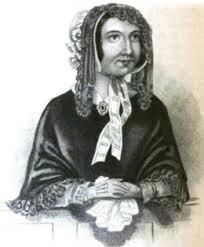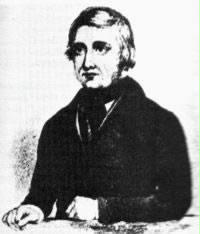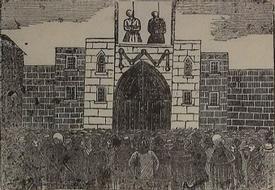Just before 9 o’clock on the morning of Tuesday, 13th November 1849, two figures emerged into the grey sky on the roof of Horsemonger lane gaol in Southwark, London. The first was a man, Frederick Manning, who had to be helped up the steep flight of stairs that led to the rooftop gallows and whose legs crumpled underneath him when he reached them. The second figure, immaculately presented in a black satin dress, was his wife, Marie Manning. She was more sure of foot as she made her way to the gallows, though she too had to be helped up the stairs as she had requested that a black veil covered her face before she emerged from the prison. An estimated 30,000 people watched as the couple had nooses placed around their necks, and there was a few seconds of tension before the executioner pulled the lever and husband and wife plunged to their deaths. Frederick died instantly, while Marie writhed around for a few seconds before staying deathly still.
The hanging was so public and the behaviour of the crowd that morning so raucous that Charles Dickens, watching from a room he had rented overlooking the scene, decided that public executions ought to be a thing of the past. But what had the Manning’s done to deserve their grim fate? Their tale was one of love, betrayal, greed… and murder. Three months previously they had murdered Marie’s wealthy lover in cold blood and attempted to cash in on their victim’s fortune, in a plot the press dubbed ‘the Bermondsey horror.’ They would be undone by new technology and the newly formed police forces that had sprung up across Britain in the previous two decades.
A deadly Love triangle develops
Marie Manning was born Marie de Roux in Lausanne, Switzerland, in 1821. She moved to England in her late teens and entered domestic service in Stafford House, one of the grandest homes in London. It was here that she developed a taste for the finer things in life and resolved that she would never again be relegated to living in the obscurity she had grown up in. She was a charismatic and good-looking woman, with a magnetic personality, dark features and healthy plumpness that attracted no shortage of admirers.
Marie de Roux attracted no shortage of male admirers
As told by Josh Salisbury, in 1846 Marie was accompanying her employer on a trip to France and met Patrick O’Connor, a 50-year-old Irishman, on the boat. O’Connor was charming and was sitting on a considerable fortune through his money lending in the dynamic railway industry, and promised Marie that he would take her out for a meal when he returned to London.
In early 1847 O’Connor made good on his promise, but by this time Marie was already in a relationship with another man – Frederick Manning. Manning was two years older than Marie and a London native, and though his job – he was a guard for a railway company – was not particularly well paid he claimed that he stood to inherit a fortune from his mother. Both men proposed marriage to Marie and she was left to decide which one she would have a better life with. O’Connor could certainly give her the luxurious life she dreamed of, but she was worried about the age gap between them and by his heavy drinking. Manning was closer in age, more easily dominated and could also, so he claimed, give her a comfortable lifestyle. She married Frederick Manning in May 1847 and the couple settled into a relatively fashionable home on Miniver Place in Bermondsey, south-east London, but it soon became apparent that he had been lying to her about being due to inherit any substantial amount of money.
Frederick Manning beat Patrick O'Connor to win Marie's hand in marriage
Fearing that she had married to wrong man, Marie re-established contact with O’Connor and before long was engaged in an affair with him. Strangely, it seems as if Frederick Manning was completely aware of the affair, and O’Connor even occasionally attended dinner at the Manning’s house. This odd situation continued for some time but by the summer of 1849 Marie and Frederick decided that it would continue no longer. Now more committed to her husband, Marie decided that she would rid herself of O’Connor – but not of his money. The couple hatched a plot to murder Patrick O’Connor and cash in on his vast fortune.
The Plot
The Manning’s decided on a simple but brutal plan. They would invite O’Connor to dinner at their house, make him feel comfortable and then shoot him with a small revolver Marie had purchased. They would then bury his body under their kitchen floor and cover it with quicklime, which would speed the decay of the corpse. The following morning, Marie would set about retrieving anything of value – including his railway share certificates – from his home in Mile End. Her presence there would not be suspicious, as she was of course a regular visitor.
The quicklime was delivered to the Manning house in late July, and the plan was set to go ahead on 8th August 1849 but was scuppered when O’Connor brought a friend, Pierce Walsh, along with him for dinner. At the end of the evening, Marie invited him back for dinner the following night but requested he come alone so that they may have some more, ahem, intimate time together. O’Connor gladly agreed.
Again, we turn to Josh Salisbury for details of what happened next. It was late on the evening of 9th August when O’Connor arrived back at the Manning home on Miniver Place, and the murderous couple wasted no time in effecting their plan. Patrick O’Connor may have had time to process that something was wrong as he walked into the kitchen, as the flagstone had been removed from the floor and the soil beneath had been dug up. But he had no time to save himself. Marie shot him in the back of the head, and he fell face first into the soil. However, the bullet from the small revolver was not enough to kill him, and he writhed in agony as Marie and Frederick looked at each other in horror. It was at this moment that Frederick desperately retrieved an iron bar and bludgeoned his victim to death. With the deed done, the couple hastily buried the body in soil and quicklime, put the flagstone back in the kitchen floor, and drank whiskey together in near silence during the sleepless night that followed.
Fugitives from justice
The morning after the murder, Marie Manning went to Patrick O’Connor’s house as planned and collected his railway share certificates and any other valuables. The couple were giddy at the thought of the wealth they were about to walk into, but they were not seasoned criminals and frankly by this point they were in over their heads. Three days after the murder, a group of Patrick O’Connor’s work colleagues visited Miniver Place in search of him, explaining to Marie that O’Connor had informed them he was to visit her for dinner on the night of his disappearance. Marie tried to remain calm and claimed that he had never shown at her house that night, and while it was enough to satisfy the enquiring men for now, she knew it would not be long before they returned.
Frederick and Marie were now terrified of a knock on the door and growing suspicious of each other. It was Marie who bolted first, fleeing on her own to Scotland with the bulk of their ill-gotten wealth. Realising he had been abandoned, Frederick hastily sold all the furniture in their home and left for Jersey with the earnings from that as well as what Marie had left for him.
In the meantime, Patrick O’Connor’s friends had reported him missing to the infant Metropolitan Police, which had only been formed twenty years previously. Officers arrived at Miniver Place to speak to the Manning’s but received no answer when they knocked on the door. Suspicious, they gained entry to the home and found it abandoned, with no furniture or occupants, and a loose flagstone in the middle of the kitchen. It was one of the easier searches the new police force would ever undertake. The flagstone was removed and sure enough, the battered body of Patrick O’Connor was quickly found. The missing persons investigation was now a murder investigation, and the hunt was on for the killers.
It was swiftly ascertained where Marie Manning had headed – enquiries at King’s Cross station revealed she had boarded a train bound for Edinburgh. The Metropolitan Police used another new invention, the telegraph, to contact their counterparts in the Scottish capital and Marie was arrested in a swanky hotel, where she was staying under a false name. It was the telegraph that also led to Frederick’s capture, after he was spotted on a boat bound for Jersey by a former acquaintance who had read about the murder in the newspapers, which had widely reported the case and dubbed it the ‘Bermondsey horror’. This information was telegraphed to police in London, who arranged for Frederick’s arrest and transfer back to the city. He was asleep in bed nursing a hangover when authorities burst into his room, and in his groggy state he admitted he had killed O’Connor because he ‘didn’t like him.’
Trial and Execution
By 23rd August both Marie and Frederick were in the same prison, and their trial began on 25th October. At this time trials were usually quick affairs, done and dusted in an hour or two, but the Manning trial took a full two days. This may partly be because there was much hand wringing from the defence and judge about selecting men from Swiss or French backgrounds to sit on the jury, so as to give Marie as fair a trial as possible. Still, the verdict was never really in any doubt, and Marie screamed profanities about the English race as she was led away from the dock.
Newspaper reports from the time give details about the murderous couple's execution. On the morning of 13th November, Frederick and Marie were brought to a chapel together to receive blessings before they were executed. Marie appeared stoic that morning, resigned to her fate and more concerned with looking her best than with what awaited her. Frederick was more emotional, trembling as they were led on a painfully long walk from the chapel to the rooftop and collapsing when he reached the gallows. As they stood before the nooses that would kill them, Marie leant over to her husband and gave him a brief kiss, a poignant moment showing that she was not the cold, money-obsessed woman she had been portrayed as in the press. However, the kiss did not much impress the 30,000 strong crowd, who were loud and disrespectful throughout the proceedings and convinced the watching Charles Dickens to campaign vigorously for a ban on public executions.
Dickens would get his wish in 1868, and another consequence of the execution was that satin dresses, which Marie had worn so elegantly when she died, almost immediately went out of fashion. In an ironic twist, the Manning’s bodies were buried with quicklime to speed up their decay. Though Frederick’s sheer terror as he went to his death and Marie’s respectable calmness and show of affection for her husband does win them some sympathy, in truth this was a fitting end for two people who did not deserve much sympathy. As they stood on the gallows high above London and observed the baying crowd before them, they must have known that they had only themselves – and their insatiable greed – to blame for the fate they were about to suffer.
PODCAST - The podcast version of this story is available on apple and spotify!
https://podcasts.apple.com/gb/podcast/the-bermondsey-horror/id1550458439?i=1000509022443
https://open.spotify.com/episode/4o0TFrk1ipbgawmlGu562V?si=OncIPaz5Qc2Jy1uM6kCZIg
Like this article? Explore the blog for more great content, and donate here! We need your support to keep the blog going!
https://www.buymeacoffee.com/tomMOH
Acknowledgements
The Ministry of History is not an academic source. Our pieces are written by writers who have been keen students of history for years and are well versed in, and influenced by, countless other writers and works. For this article specifically our sources have included:
‘Marie Manning’, article published by Murderpedia.com
‘Marie and Frederick Manning’, article published by capitalpunishmentuk.org
‘The Bermondsey Horror’, documentary by Murder Maps (2015)
‘The 1849 Bermondsey Horror: How dinner at the Mannings’ turned into a deadly affair’, article by Josh Salisbury, published by southwarknews.co.uk (2019)

.jfif)


